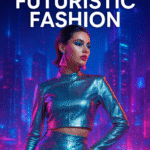
Retro Futuristic Fashion: A Style from Tomorrow’s Past
November 4, 2025
Futuristic Maternity Wear: Revolutionizing Pregnancy Fashion in 2025 and Beyond
November 5, 2025The mid-20th century was a time of boundless optimism. As humanity reached for the stars, the collective imagination soared, dreaming of a future filled with technological marvels and interplanetary travel. This excitement didn’t just fuel scientific endeavors; it ignited a cultural revolution that profoundly influenced design, art, and, most notably, fashion. The result was space age futuristic clothing, a style that captured the sleek, adventurous spirit of the era and forever changed how we envision dressing for tomorrow.
This article delves into the world of space age futuristic clothing. We will explore its origins during the height of the Space Race, break down its defining characteristics, and examine its lasting legacy on contemporary fashion. From metallic fabrics to geometric silhouettes, prepare to journey back to a future envisioned decades ago, a style that remains remarkably relevant today.
What Defines Space Age Futuristic Clothing?
Space age futuristic clothing is an aesthetic born from the cultural zeitgeist of the 1950s and 1960s. It is a direct reflection of the period’s obsession with space exploration, technology, and a utopian vision of the future. At its heart, this fashion movement was not about practicality for actual space travel but about capturing the idea of it. It was fashion as fantasy, translating the clean lines of rockets and the shimmer of distant stars into wearable art.
Designers of the time sought to break free from the traditional, often restrictive, fashions of the preceding decades. They imagined a world where clothing was minimalist, functional, and constructed from revolutionary new materials. This style is characterized by its bold simplicity, experimental textures, and an overarching sense of looking forward. It embodies the hope and wonder of a society on the brink of a new technological dawn.
The Birth of a Movement: Fashion and the Space Race
The race to the moon between the United States and the Soviet Union was more than a political contest; it was a powerful cultural catalyst. Every rocket launch and satellite orbit was televised, bringing the cosmos into living rooms around the world. This constant stream of futuristic imagery provided fertile ground for fashion designers who were eager to innovate.
The Pioneers of the Cosmos
A handful of visionary designers led the charge, translating the aesthetics of space exploration into groundbreaking collections. Their work laid the foundation for space age futuristic clothing and continues to inspire designers today.
- André Courrèges: Often hailed as the father of the space age look, Courrèges introduced his “Moon Girl” collection in 1964. It was a radical departure from the norm, featuring stark white and silver palettes, A-line mini dresses, go-go boots, and helmet-like hats. He utilized unconventional materials like PVC and vinyl to create structured, geometric garments that felt entirely new.
- Paco Rabanne: Known for his avant-garde approach, Rabanne took the use of materials to another level. He famously created dresses from linked plastic discs, metal plates, and aluminum. His work was less about wearability and more about making a statement, crafting pieces that looked like futuristic armor for a new kind of woman.
- Pierre Cardin: Cardin was a master of geometric shapes and unisex fashion. He introduced the “bubble dress” and was known for his use of circular and linear motifs, often inspired by astronaut helmets and portholes. He believed clothing should be liberating and forward-thinking, creating designs that blurred traditional gender lines.
These designers were not just making clothes; they were building a new visual language. Their work captured the era’s optimism and its belief that technology and design could create a better, more exciting world.
Core Elements of Space Age Style
While individual designers had their unique signatures, several key characteristics unite space age futuristic clothing, making it instantly recognizable.
Revolutionary Materials and Textures
The space age look was defined by its embrace of the synthetic and the man-made. Natural fibers like cotton and wool were pushed aside in favor of materials that felt modern and innovative.
- Metallics and Vinyl: Silver was the quintessential color of the era, mimicking the polished metal of spacecraft. Vinyl, PVC, and other high-shine plastics were used to create a sleek, waterproof, and futuristic sheen.
- Synthetics: Fabrics like nylon and polyester, which were still relatively new, were favored for their durability and ability to hold unconventional shapes.
- Unusual Embellishments: Designers incorporated non-traditional elements like metal links, plastic discs, and large zippers to enhance the high-tech feel.
Geometric Silhouettes and Clean Lines
The shapes of space age futuristic clothing were simple, sharp, and architectural. The goal was to create a sense of structure and minimalism, moving away from the fussy details of earlier fashion.
- A-Line and Shift Dresses: The short, A-line mini dress became the uniform of the “Moon Girl,” offering a sense of freedom and youthfulness.
- Sharp Cutouts: Strategic cutouts—circles, squares, and ovals—were used to add visual interest and reinforce the geometric theme.
- Boxy and Unisex Shapes: Jackets and tunics often had a boxy cut, minimizing the body’s natural curves in favor of an androgynous, streamlined silhouette.
A Minimalist and Contrasting Color Palette
Color was used with intention. The palette was often limited to create maximum impact.
- Optic White and Silver: This combination was the most iconic, evoking the sterile environment of a spaceship and the brightness of distant stars.
- Monochromatic Looks: Outfits were frequently composed of a single, solid color to emphasize the garment’s shape.
- Bold Color Blocking: When color was used, it was often in the form of bold, graphic blocks of primary colors set against a white or black background.
Futuristic Accessories
Accessories were essential for completing the space age look. They were often as bold and imaginative as the clothes themselves.
- Go-Go Boots: Flat or low-heeled boots, typically in white or silver vinyl, were a staple.
- Helmet-Like Hats: Headwear often mimicked the shape of astronaut helmets.
- Oversized Sunglasses: Large, often plastic-framed sunglasses in geometric shapes added a sense of mystery and cool.
The Enduring Legacy of Space Age Fashion
The peak of the original space age futuristic clothing movement may have been in the 1960s, but its influence never truly faded. The aesthetic has been cyclically revisited and reinterpreted by designers in the decades since.
Elements of the space age look reappear on runways with regularity. Designers like Nicolas Ghesquière and the late Alexander McQueen have famously drawn inspiration from its sleek lines and experimental nature. Metallic fabrics, sharp silhouettes, and a futuristic sensibility can be seen in modern collections, proving the timeless appeal of this forward-looking style.
Today, you can see echoes of the space age in everything from high-fashion metallic puffer jackets to the clean, minimalist designs favored by many contemporary brands. It has become part of our collective fashion vocabulary, a symbol of optimism and endless possibility.
FAQs About Space Age Futuristic Clothing
Q: How is space age fashion different from retro-futurism?
A: Space age futuristic clothing specifically refers to the fashion movement of the 1960s inspired by the Space Race. Retro-futurism is a broader term that describes any style that looks back at a past era’s vision of the future. So, the original 1960s space age fashion is a primary example of what later became known as retro-futurism.
Q: Can I wear this style today without looking like I’m in a costume?
A: Absolutely. The key is to incorporate elements subtly. You can start with a single statement piece, like a silver jacket or a pair of metallic boots, and pair it with modern basics like jeans or black trousers. A dress with a clean, geometric cut or accessories with a space age feel can also add a futuristic touch to a contemporary wardrobe.
Q: Where can I find space age-inspired clothing?
A: You can find original vintage pieces from the 1960s in high-end vintage stores or online marketplaces, though they can be rare and costly. For a more accessible option, look for modern designers who are inspired by the aesthetic. Many contemporary brands incorporate metallic fabrics, vinyl, and minimalist silhouettes into their collections.
Q: What materials are most associated with space age fashion?
A: The most iconic materials are PVC, vinyl, plastics, and metallic fabrics, especially in silver. Synthetic fibers like polyester and Lurex were also very popular. The focus was on anything that looked man-made, glossy, and technologically advanced.
Final Words
Space age futuristic clothing was more than a trend; it was a cultural phenomenon. Born from a unique moment in history when humanity’s gaze was fixed on the stars, it captured a collective dream of a brighter, bolder future. Its pioneers dared to imagine a world transformed by technology and reflected that vision in clothes that were innovative, optimistic, and radically different.
The clean lines, metallic shine, and geometric precision of the style continue to fascinate and inspire us. It serves as a reminder that fashion at its best is not just about clothing the body, but also about expressing our hopes, dreams, and ideas. By looking back at this iconic movement, we can still feel a spark of that original excitement for the world of tomorrow.



